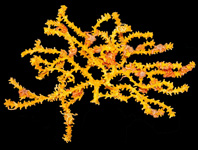Abstract
Two new species of Petrobunus Sharma & Giribet, 2011, (Petrobunidae) are described: P. chongqing sp. nov. (♀♂) and P. hebei sp. nov. (♀♂). Petrobunus chongqing sp. nov. is similar to P. spinifer Sharma & Giribet, 2011, in having two large spines on the male sternite 7. However, the new species can be distinguished from P. spinifer by the absence of a ventral tubercle on the male femur IV, as well as the presence of three pairs of enlarged tubercles on the lateral margin of area V and free tergites I–II. Petrobunus hebei sp. nov. and P. torosus Sharma & Giribet, 2011 closely resemble each other. They are distinguished by the morphology of the ocularium, in that P. torosus has a median tubercle whereas the ocularium of P. hebei sp. nov. is unarmed. The discovery and descriptions of these species greatly expand the known range of the genus Petrobunus.
References
Clouse, R.M. & Giribet, G. (2010) When Thailand was an island – the phylogeny and biogeography of mite harvestmen (Opiliones, Cyphophthalmi, Stylocellidae) in Southeast Asia. Journal of Biogeography, 37, 1114–1130.
https://doi.org/10.1111/j.1365-2699.2010.02274.xFernández, R., Sharma, P.P., Tourinho, A.L. & Giribet, G. (2017) The Opiliones tree of life: shedding light on harvestmen relationships through transcriptomics. Proceedings of the Royal Society of London B: Biological Sciences, 284, 20162340.
https://doi.org/10.1098/rspb.2016.2340Giribet, G., Sharma, P.P., Benavides, L.R., Boyer, S.L., Clouse, R.M., de Bivort, B.L., Dimitrov, D., Kawauchi, G.Y., Murienne, J. & Schwendinger, P.J. (2012) Evolutionary and biogeographical history of an ancient and global group of arachnids (Arachnida: Opiliones: Cyphophthalmi) with a new taxonomic arrangement. Biological Journal of the Linnean Society, 105, 92–130.
https://doi.org/10.1111/j.1095-8312.2011.01774.xMacías-Ordóñez, R., Machado, G., Pérez-González, A. & Shultz, J. (2010) Genitalic Evolution in Opiliones. In: Leonard, J. & Córdoba-Aguilar, A. (Eds.), The Evolution of Primary Sexual Characters in Animals. Oxford University Press, New York, pp. 285–306.
Roewer, C.F. (1912) Die Familien der Assamiiden und Phalangodiden der Opiliones-Laniatores. (=Assamiden, Dampetriden, Phalangodiden, Epedaniden, Biantiden, Zalmoxiden, Samoiden, Palpipediden anderer Autoren). Archiv für Naturgeschichte, (A), 78 (3), 1–242.
Schwendinger, P.J. & Martens, J. (2002) A taxonomic revision of the family Oncopodidae III: Further new species of Gnomulus Thorell (Opiliones, Laniatores). Revue suisse de zoologie, 109, 47–113.
https://doi.org/10.5962/bhl.part.79580Sharma, P.P. (2012) New Australasian Zalmoxidae (Opiliones: Laniatores) and a new case of male polymorphism in Opiliones. Zootaxa, 3236, 1–35.
Sharma, P.P., Buenavente, P.A.C., Clouse, R.M., Diesmos, A.C. & Giribet, G. (2012) Forgotten gods: Zalmoxidae of the Philippines and Borneo (Opiliones: Laniatores). Zootaxa, 3280, 29–55.
Sharma, P.P. & Giribet, G. (2009) Sandokanid phylogeny based on eight molecular markers—The evolution of a southeast Asian endemic family of Laniatores (Arachnida, Opiliones). Molecular Phylogenetics and Evolution, 52, 432–447.
https://doi.org/10.1016/j.ympev.2009.03.013Sharma, P.P. & Giribet, G. (2011) The evolutionary and biogeographic history of the armoured harvestmen—Laniatores phylogeny based on ten molecular markers, with the description of two new families of Opiliones (Arachnida). Invertebrate Systematics, 25, 106–142.
https://doi.org/10.1071/IS11002Sharma, P.P. & Giribet, G. (2012) Out of the Neotropics: Late Cretaceous colonization of Australasia by American arthropods. Proceedings of the Royal Society of London B: Biological Sciences, 279, 3501–3509.
https://doi.org/10.1098/rspb.2012.0675Sharma, P.P., Santiago, M.A., Kriebel, R., Lipps, S.M., Buenavente, P.A.C., Diesmos, A.C., Janda, M., Boyer, S.L., Clouse, R.M. & Wheeler, W.C. (2017) A multilocus phylogeny of Podoctidae (Arachnida, Opiliones, Laniatores) reveals the disutility of subfamily nomenclature and traditional character systems in armored harvestman systematics. Molecular Phylogenetics and Evolution, 106, 164–173.
https://doi.org/10.1016/j.ympev.2016.09.019

